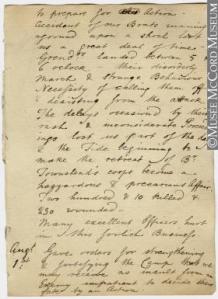
On June 27, 1759, the British force under General Wolfe and Admiral Saunders completed the voyage up the St. Lawrence to Quebec. They had been guided safely through “the traverse,” the most dangerous stretch of the river, by Captain Cook. Actually, Cook tricked some French river pilots into helping him. The first British ships that entered the St. Lawrence flew “fleur-de-lis” flags. The pilots went on board believing them to be French, and were forced to help guide the fleet up the river. They were furious and kept shouting that Quebec would be the tomb of the invaders, and that their scalps would decorate the walls of the city!
The fleet came within sight of Quebec on June 26, and Wolfe’s soldiers began disembarking on the Island of Orleans on June 27. Wolfe issued a proclamation to the Canadians, commanding them to remain passive spectators, but many of them flocked to join Montcalm’s forces.
Montcalm had arrived at Quebec on May 22. With Brigadier Lévis, he made a tour of the entire area and rearranged artillery batteries. The beach at Beauport gave him the greatest concern, and he installed a floating battery of twelve heavy guns, and six fire ships, loaded with explosives. These ships were bought by the crooked Intendant Bigot, who made a profit for himself even at that hour of danger.

Paper 19 x 14 cm
Gift of Mr. David Ross McCord
M255 © McCord Museum
Montcalm had two great handicaps working behind the scene. One was Bigot, and the other was Governor Vaudreuil himself. Montcalm should have sent a strong force to hold the high ground across the river, now Lévis. It is believed that Vaudreuil vetoed this plan. Wolfe quickly took advantage of the opening and installed British guns there. They pounded Quebec until its capture in September.
The fire ships, Vaudreuil’s idea, were a complete failure. They were floated down the river towards the British fleet. When the commander of the leading fire-ship panicked and deserted, others followed, and finally only one captain remained with his ship and was burned to death. When the fire ships came close, the British sailors simply put grappling hooks on them and towed them to shore. While they burned, the sailors cheered heartily.
This was only the beginning. The battle for Quebec continued until September 13, when it was concluded on the Plains of Abraham.
I just learned about Musee du Fort, who are in Quebec City, Quebec, and have a show about “The Great Battles of Quebec City.” Thank you Randy!.
To read more about the battles, I have found a few sites you may want to visit. Maybe start at British Battles.com, and then From the Warpath To The Plains of Abraham (a very good article here). If you still want to read more, then I suggest About.com for an article by Kennedy Hickman, called “French & Indian War: Battle of Quebec (1759).”
Related articles
- “We Shall Probably Succeed” (tkmorin.wordpress.com)
- Conrad Black: High Noon at the Plains of Abraham (huffingtonpost.com)
- The “Conquest” of New France (michelinewalker.com)


And that is the beginning of New French?
LikeLike
I really enjoyed this post! We were just in le Vieux Quebec and also visited the Ile d’Orleans. While we rode past the Plains of Abraham outside the City’s walls several times (once in a caleche), we skipped la Musee du Fort — next time!
LikeLike
From what I read, it looks like a great place to stop! But it also sounds as if you saw quite a bit of Old Quebec! Thanks for dropping by and commenting — always appreciated!! 🙂
LikeLike
Great story, great glory, now I have to calm my PTSD. Even reading about combat causes a trigger of anxiety, but what can I do, I’m a war boy…great article..
LikeLike
Thanks, Michael. It is too bad there were so many such battles in our Country’s past. But alas, there were. Thanks for dropping by! 🙂
LikeLike
My pleasure…great history read…
LikeLike
There is an amazing diorama show in Quebec City that explains this entire exchange, which is an absolute must-see if you ever visit that beautiful town.
I first saw it as a school boy on a field trip to QC and have made a pilgrimage to see it whenever I have returns in the intervening 35 years.
Le Musee du Fort: http://www.museedufort.com/site/home_en.html
LikeLike
How fascinating! I love it! I’m going to add it to my post! Hopefully, if anyone is in the area, they’ll go visit it! Thank you! 🙂
LikeLike
I seem to remember you posting something else recently about another time someone was tricked with a flag, right? Was that a common tactic?
LikeLike
The man’s name was Bigot??? Interesting. The fire ships are interesting also, but what a horrible way to die.
LikeLike
Yeah. To die like that, for what turned out to a failure … But then, hindsight is everything!
LikeLike